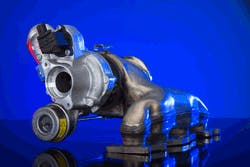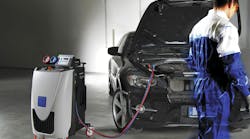BorgWarner’s optimized turbocharging technology powers all new four-cylinder gasoline engines from Volvo. The backbone of Volvo’s gasoline Drive-E powertrain family, the fuel-efficient engines are available for nearly all models in four different variants and achieve a power output of 152 HP (112 kW) to 320 HP (236 kW). While delivering a maximum torque of 250 to 400 Nm, BorgWarner’s turbochargers help these gasoline engines set new standards of efficiency and performance. All of BorgWarner’s optimized turbochargers feature an integrated sheet-metal turbine housing for improved thermal insulation and reduced surface temperature. The compact and lightweight turbochargers have a modular design to meet Volvo’s powertrain strategy.
To provide a high degree of commonality between engine parts in a compact design, BorgWarner engineers developed an air-gap insulated sheet metal turbine housing for the turbochargers with a virtually identical external geometry suitable for use in all engines. The innovative housing consists of several stamped sheet-metal parts that are welded together, resulting in improved thermal insulation and reduced surface temperature to withstand exhaust temperatures of up to 1,796 F (980°C).
Further benefits of the design are a wider performance range from a low-inertia turbine wheel and a better transient response due to the improved utilization of exhaust gas pulsation. As a result, the catalytic converter is activated more rapidly during cold starts for significantly reduced emissions. To prevent charge pressure at very high engine power, the turbochargers are fitted with a wastegate. Built to deliver powerful yet efficient performance, these turbocharging technologies provide excellent torque characteristics over the entire engine speed range while improving fuel economy.
Subscribe to Motor Age and receive articles like this every month…absolutely free. Click here


